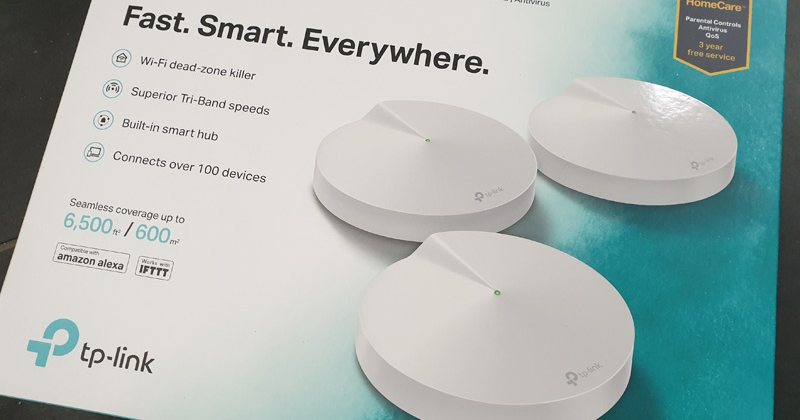Review: TP-Link - Deco M9 Plus

A single Wi-Fi router doesn't quite cover my entire house, so in the past I had several Wi-Fi routers in different locations. This worked OK, except Wi-Fi client devices wouldn't automatically jump to a closer router when moved (even with both routers using the same SID). Instead, you had to manually turn Wi-Fi off/on on the device - or use different SIDs and manually change between them.
So, I purchased this TP-Link Deco M9 Plus package to try to solve this issue.
The physical design of these devices is clean and discrete (reminds me off a smoke alarm) and invite in-view placement. Oddly, they have no screw holes or bracket for wall/ceiling mounting...
On the technical side, this also started out a bit frustrating. First it required me to install an app on an Android or IOS device (why not use a web-interface?), then create and log into a TP-link "sky-account" (why do I need an account on the Internet to setup my private network?). But after this, it was pretty straight forward.
I had hoped that this could also replace my old NAT router for Internet access. Unfortunately it turns out that the built-in DHCP server is too basic (only DNS addresses are configurable). In "router mode", it isn't even possible to disable the DHCP server. So I ended up using the TP-link system in "accesspoint" only mode, and keeping my old NAT router and DHCP server. This also prevents me from using the built-in "HomeCare" security features. I really hope they come out with a firmware fix - at least add an option to disable the DHCP server (while keeping NAT).
That said, automatic client jumping between accesspoints, which was my primary reason for buying this, does work very well. All client devices that I tested with (Samsung phone, Dell Windows laptop, iPads, Google ChromeCasts, Brother printer, and a few more) connected easily at good speeds, and automatically and seamlessly jumped between accesspoints when moved around the house. Both the app and the web-interface (very limited "read-only") provide information about which devices are connected to which accesspoints, etc.
I was also very pleased to note that satelite accesspoints support and automatically use Ethernet backhaul if connected.
This TP-link system also has a "smart hub" for smart-home devices. I was considering using this with my Philips Hue lights - perhaps even replacing the Hue Bridge, but it doesn't look like this even has an API (I use the REST API on the Hue Bridge to integrate with other home automation stuff).
Pros
- Wi-Fi works well and fast.
- Moved devices automatically and seamlessly jump between accesspoints.
- Satelite accesspoints can use Ethernet backhaul.
- App and web-interface provide information about which devices are connected to which accesspoints.
Cons
- Must use Android/IOS app to setup/configure (no web-interface for configuration).
- Must create and log into TP-link "sky-account" to setup and configure.
- Extremely basic DHCP server that cannot be disabled (in router mode).
- Smart hub has no public API.
- No screw holes or bracket for wall/ceiling mounting.